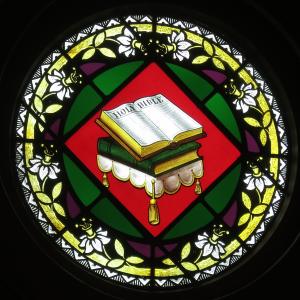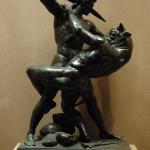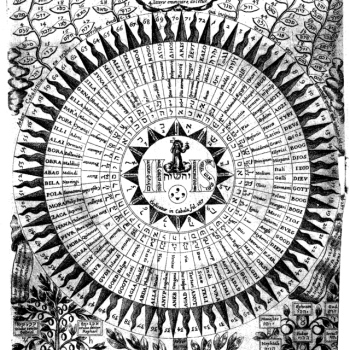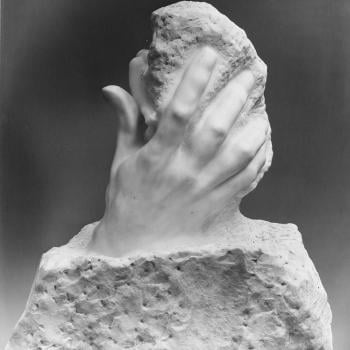CAPUT III.
What are the affirmative expressions respecting God, and what the negative.
SECTION I.
 IN the Theological Outlines, then, we celebrated the principal affirmative expressions respecting God—-how the Divine and good Nature is spoken of as One—-how as Threefold—-what is that within it which is spoken of as Paternity and Sonship—-what the Divine name of “the Spirit “is meant to signify,—-how from the immaterial and indivisible Good the Lights dwelling in the heart of Goodness sprang forth, and remained, in their branching forth, without departing from the coeternal abiding in Himself and in Themselves and in each other,—-how the super-essential Jesus takes substance in veritable human nature—-and whatever other things, made known by the Oracles, are celebrated throughout the Theological Outlines; and in the treatise concerning Divine Names, how He is named Good—-how Being—-how Life and Wisdom and Power—-and whatever else belongs to the nomenclature of God. Further, in the Symbolical Theology, what are the Names transferred from objects of sense to things Divine?—-what are the Divine forms?—-what the Divine appearances, and parts and organs?—-what the Divine places and ornaments?—-what the angers?—-what the griefs?—-and the Divine wrath?—-what the carousals, and the ensuing sicknesses?—-what the oaths,—-and what the curses?—-what the sleepings, and what the awak-ings?—-and all the other Divinely formed representations, which belong to the description of God, through symbols. And I imagine that you have comprehended, how the lowest are expressed in somewhat more words than the first. For, it was necessary that the Theological Outlines, and the unfolding of the Divine Names should be expressed in fewer words than the Symbolic Theology; since, in proportion as we ascend to the higher, in such a degree the expressions are circumscribed by the contemplations of the things intelligible. As even now, when entering into the gloom which is above mind, we shall find, not a little speaking, but a complete absence of speech, and absence of conception. In the other case, the discourse, in descending from the above to the lowest, is widened according to the descent, to a proportionate extent; but now, in ascending from below to that which is above, in proportion to the ascent, it is contracted, and after a complete ascent, it will become wholly voiceless, and will be wholly united to the unutterable. But, for what reason in short, you say, having attributed the Divine attributes from the foremost, do we begin the Divine abstraction from things lowest? Because it is necessary that they who place attributes on that which is above every attribute, should place the attributive affirmation from that which is more cognate to it; but that they who abstract, with regard to that which is above every abstraction, should make the abstraction from things which are further removed from it. Are not life and goodness more (cognate) than air and stone? and He is not given to debauch and to wrath, more (removed) than He is not expressed nor conceived.
IN the Theological Outlines, then, we celebrated the principal affirmative expressions respecting God—-how the Divine and good Nature is spoken of as One—-how as Threefold—-what is that within it which is spoken of as Paternity and Sonship—-what the Divine name of “the Spirit “is meant to signify,—-how from the immaterial and indivisible Good the Lights dwelling in the heart of Goodness sprang forth, and remained, in their branching forth, without departing from the coeternal abiding in Himself and in Themselves and in each other,—-how the super-essential Jesus takes substance in veritable human nature—-and whatever other things, made known by the Oracles, are celebrated throughout the Theological Outlines; and in the treatise concerning Divine Names, how He is named Good—-how Being—-how Life and Wisdom and Power—-and whatever else belongs to the nomenclature of God. Further, in the Symbolical Theology, what are the Names transferred from objects of sense to things Divine?—-what are the Divine forms?—-what the Divine appearances, and parts and organs?—-what the Divine places and ornaments?—-what the angers?—-what the griefs?—-and the Divine wrath?—-what the carousals, and the ensuing sicknesses?—-what the oaths,—-and what the curses?—-what the sleepings, and what the awak-ings?—-and all the other Divinely formed representations, which belong to the description of God, through symbols. And I imagine that you have comprehended, how the lowest are expressed in somewhat more words than the first. For, it was necessary that the Theological Outlines, and the unfolding of the Divine Names should be expressed in fewer words than the Symbolic Theology; since, in proportion as we ascend to the higher, in such a degree the expressions are circumscribed by the contemplations of the things intelligible. As even now, when entering into the gloom which is above mind, we shall find, not a little speaking, but a complete absence of speech, and absence of conception. In the other case, the discourse, in descending from the above to the lowest, is widened according to the descent, to a proportionate extent; but now, in ascending from below to that which is above, in proportion to the ascent, it is contracted, and after a complete ascent, it will become wholly voiceless, and will be wholly united to the unutterable. But, for what reason in short, you say, having attributed the Divine attributes from the foremost, do we begin the Divine abstraction from things lowest? Because it is necessary that they who place attributes on that which is above every attribute, should place the attributive affirmation from that which is more cognate to it; but that they who abstract, with regard to that which is above every abstraction, should make the abstraction from things which are further removed from it. Are not life and goodness more (cognate) than air and stone? and He is not given to debauch and to wrath, more (removed) than He is not expressed nor conceived.
Dionysius confirms that his talk about union with God conforms with the teachings of the Christian faith. After telling us that we must accept our ignorance in order to silence ourselves and welcome the revelation of God in that silence, Dionysius explains that the doctrinal contents of the Christian faith must be seen as coming from the self-revelation of God.
Apophatic theology reminds us of the limits of our knowledge and understanding of God. It embraces the mysterious elements of the truth which lie behind all kataphatic conventions used to represent and explain the truth, recognizing that in all such positive declarations, there will be innumerable antinomies which many will mistaken as being logical contradictions. For this reason, it tells us we must affirm the truth through silence, allowing the greatness of God to be discerned through a transcendental mystical encounter and spiritual dialogue with God. To truly encounter God, to reach for the truth which transcends our comprehension, we must be lifted up out of ourselves so that we can discern and see all things in and through God.
All that is taught in relation to the mystical approach to God must be understood in relation to the definitive teachings proclaimed by the Christian faith. Dionysius, in his apophatic theology, recognizes that Christians must accept the way God revealed himself to us in his universal revelation (through the oracles of Scripture as well as in and through the incarnation). God, being great and transcendent to us, knows how to reveal himself through human conventions; what he reveals can be, indeed, should be said to be true, though of course, it is truth established in a conventional form, which means, it approximates the absolute truth in a form which conforms to the limits of human reason. The difference between the conventional and absolute representations of truth demonstrate why paradoxes develop when the absolute truth is designated through conventional forms; those who argue with it are seeking the absolute truth in a form which cannot hold it.
When we want to teach others, we teach through words; when we reach out and explore the revealed truths of God, we do so in forms and symbols and names which are fitting. But it must always be kept in mind that this is why the letter is dead, and that those who seek to affirm the absolute truth in the letter instead of the spirit and meaning implied by the letter, will end up finding internal contradictions which makes them believe what has been said must be rejected.
What is often forgotten, because of the importance Dionysius gives to apophatic theology, is that Dionysius understood theology is best begun with an engagement with kataphatic theology, in revealed and doctrinal conventions, with authenticated names and symbols used to express the truth, because they are the basis by which we first address the truth and demonstrate to us the need to receive authentic revelation from God for us to ascend our understanding of the truth. What apophatic theology provides is the secondary no to the letter which is being used to express the truth, not a no to the truth which is being represented by it. The truths of the Christian faith must be affirmed, but then it must be understood, we affirm them according to the meaning they point to, not the letter, so that we begin to confirm them according to their real intent and not merely how we try to level them down to some sort of truth derived by human reason.
Dionysius, in his writings, began with texts such as his Theological Outlines and Divine Names, before addressing the fullness of apophatic thought in his Mystical Theology. The truth is to be preserved, not nihilistically denied; in his apophatic turn, the positive truths displayed in conventional form remain true and are to be affirmed as conventional representations of that truth, to make sure we are not turning our apophaticism into a relativistic nihilism which allows for no truth. It is because of the absolute truth that the conventional truth is true, but the conventional truth is true insofar as it continues to participates in and point to the absolute truth.
Dionysius, therefore gives an overview of the previous works in his Mystical Theology to remind the reader, the one who wants to honor God, that his apophaticism comes out of his affirmation of the Christian faith and must not be read as its denial. In this fashion, he first points to his Theological Outlines:
IN the Theological Outlines, then, we celebrated the principal affirmative expressions respecting God—-how the Divine and good Nature is spoken of as One—-how as Threefold—-what is that within it which is spoken of as Paternity and Sonship—-what the Divine name of “the Spirit “is meant to signify,—-how from the immaterial and indivisible Good the Lights dwelling in the heart of Goodness sprang forth, and remained, in their branching forth, without departing from the coeternal abiding in Himself and in Themselves and in each other,—-how the super-essential Jesus takes substance in veritable human nature—-and whatever other things, made known by the Oracles, are celebrated throughout the Theological Outlines;
The Theological Outlines is a work which is apparently lost.[1] It appears to be a work which engages the persons of the Godhead, discussing and explaining the distinctions between the different persons as well as the unique incarnation of the Word of God. While it affirmed the simplicity and unity of God – hence, the the Divine and good Nature is spoken of as One, it appears to be more focused on the categories which distinguish the three persons from each other: what is that within it which is spoken of as Paternity and Sonship—-what the Divine name of “the Spirit “is meant to signify. From what we know of the work, Dionysius clearly accepted the conventional names of Father, Son and Holy Spirit for the persons of the Trinity while acknowledging the great mystery which is presented to us when we understand the one God to be a Trinity.
To say that God is one and three requires us to understand God is not composed of parts; the divinity is one whole which is understood to have three relative or logical distinctions coming from that oneness. Dionysius explained this by saying: immaterial and indivisible Good the Lights dwelling in the heart of Goodness sprang forth, and remained, in their branching forth, without departing from the coeternal abiding in Himself and in Themselves and in each other. The unity of the Trinity means that where one person is, the others are there with him, just like Jesus indicated when he said he is in the Father and the Father is in him (cf. Jn. 14:8-11). While there is no substantial division between the persons to established multiple gods, they are still to be understood as branching forth from each other, allowing for personal qualities which we can attribute to one but not another. Thus, the Father begets the Son, the Son is begotten of the Father, with the Father not being begotten nor the Son begetting, even as the Spirit is said to spirate from the Father and through the Son. They branch forth in a way to differentiate each from each other while nonetheless remaining substantially one and undivided; they are always together even in their relative distinctions. The Trinity is established in the particular designations and names given to each of the divine persons; nonetheless, because God the Word, God the Son, became incarnate, a special discussion is to be had of him, showing that he also has other names and designations which are his alone due to the humanity which he assumed. And how do we know these names? Through the self-revelation of God, given to us in Scripture, the Oracles of God. This will always be the foundation of authentic mysticism: it is a revelation of the truth given to the mystic and not some mental construct they create while trying rationalize the truth of God by the power of human reason alone.
[Image=Stain Glass Window in Holy Trinity Catholic Church by By Nheyob [CC BY-SA 4.0 (https://creativecommons.org/licenses/by-sa/4.0)], from Wikimedia Commons]
[1] While some think it was never written, I agree with those who think it was but later lost because Dionysius writes of it in such a way that he expects his reader to have access to them.
Stay in touch! Like A Little Bit of Nothing on Facebook













